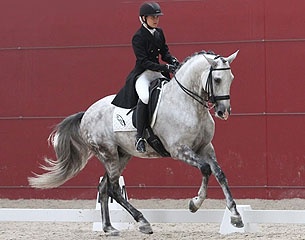
Stretching is a vital element to the training of dressage. It is the reward to the horse, it loosens the horse's body and it allows the energy to flow naturally through the horse, while confirming and testing every aspect of the training. However, there is often big confusion between a beneficial, positive, rewarding, engaged, elastic, “through” stretch; as opposed to a long, flat, out-the-back, running, “drink of water” stretch. The focus falls on the horse's ability to stretch out his neck and while this is a key element, it is just ONE of many key elements inherent in an effective stretch.
My trainer says that the most important thing to remember as we let the horse stretch, is not to loose the roundness and engagement of the gait, and while length in the neck is important, the stretch is actually a test of whether the horse's energy is being driven by the hindlegs, through the horse and into an elastic contact.
“It is important to remember not to let the horse get long through the body in the stretch. Length in the neck is not length in the body and we must think that the horse stays round through the stretch and that the power is driven from the back to the front," my coach explained. "If we simply let the reins out long, the horse might open his neck angle, but without engagement and the energy channeling through from behind, we will loose the power out the back and the horse will become longer (his hindlegs going further out behind him."
Nuno Oliviera used to say that “relaxation is not lack of energy”, meaning that when we relax our horse, we must ensure that we maintain the activity and impulsion so that we can test if our horse is working correctly over his back.
How many times have we seen a rider that is holding the horse up in a collected frame and because they have not established correct impulsion and lightness, when they let the reins out to stretch the horse, the horse goes “plop” on the forehand, his hind legs go out behind him like a duck, his back gets flat and long, and his trot goes, “piddle piddle piddle, run run run!” His neck is longer, sure, but what else has the rider missed in the mean time?
If a rider has their horse engaged into the contact, “through”, with the energy coming from the back of the horse, when they gently let the reins out, they will at the same time lift and engage the horse so that as his neck lengthens, he will lift slightly across his top line, creating a lovely curve up over his back and the length will thus be seen only in his top line and not in the flat pancake across his back. I call it the “bold” stretch, as it feels as if my horse is on a gliding mission!
Nuno said that in the entire work (that is all of it) it is “important that the rider gets the feeling that the haunches are pushing the body of the horse, not that they are following it.”
If you let the energy go and the horse falls forward and lets his neck out, all the energy will escape and the horse will chase his front end around the arena. If a rider lifts and allows gently, until the horse can balance and stretch without losing his energy flow, the stretch becomes an effective tool in the rider's ability to engage, relax, strengthen, and elasticise the horse. Then, just as the stretch can test if you have the horse's weight on the hindlegs and the energy flowing “up and out the front door”, you can use the work to test your stretch.
This means that once you have established a working, active engaged stretch, where the back of the horse lifts and he becomes rounder, “bolder,” in his work, you can gently retake the reins, shift your weight back and ask the horse to come back into a more collected frame.
Can you do this without hauling him up off the floor of the arena? Can you do this with the use of seat and leg? Do you feel the power lift him up, or do you?
The transition to and from the stretch, should be executed with ease, balance, flow, and should seem as the rider merely shifts the energy a little, embraces the horse, boosts the cadence and re-establishes a rounded neck, elastic contact and collected position both in terms of rider and horse; posture and outline.
Active stretch or long, flat running: put your stretch to the test!
by Sarah Warne
Related Links
Classical Training: Pilates Recovery - The Highs and Lows of Dressage
Classical Training: We Are All Crazy - The Highs and Lows of Dressage